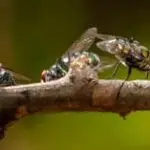How Many Eyes Do Flies Have?
Despite being tiny creatures, flies have remarkably complex eyes. They contain thousands of small cameras that form a single image. This enables them to see in all directions. The eyes of flies are studied by scientists to improve robotic technology. These insects also have very small brains compared to humans. The reason for their complexity may be as simple as their ability to feel pain. The two eyes of a fly help them avoid predators and detect movement.
The eyes of flies are similar to those of humans, but have some striking differences. For example, male flies have a region of the eye called the ‘love spot’. Male flies process visual signals in this area 60 percent faster than female flies, giving them an advantage in locating potential mates.
Despite having nearly 360-degree vision, flies’ eyes are tiny compared to humans’. Their tiny heads also make it difficult to house the large number of facets needed for good vision. They also have low contrast sensitivity and poor color-diffference. This means that their vision isn’t as sharp as ours is. However, their fast movement and sensitivity to light allow them to detect and process light rapidly. In comparison, humans can only distinguish up to 60 discrete flashes of light every second. This can vary depending on the lighting conditions and the part of the retina that receives light.
Flies’ compound eyes are comprised of thousands of individual visual receptors, called ommatidia. These tiny images act as a compass for the insect, and allow it to move around the environment. These structures are also known as ommatidia, and they contain clusters of photoreceptor cells, support cells, and pigment cells.








